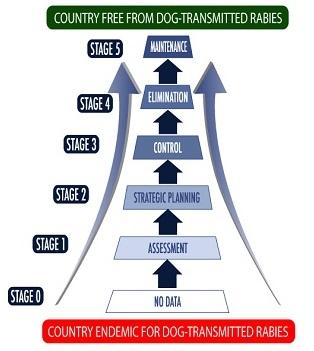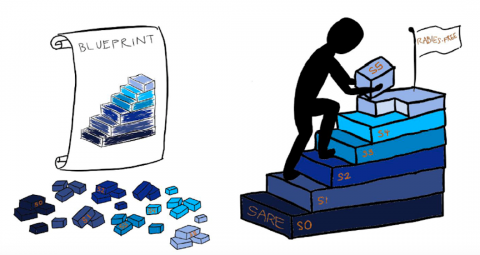Editorial: Strengthening the Stepwise Approach towards Rabies Elimination (SARE)
The realization that programs for rabies control and elimination require several chronological and critical steps has been well recognized over the past decades and is supported by examples from the developed world where rabies elimination has been achieved.
Rabies epidemiology is not entirely simple, and we are still gaining new information on transmission dynamics, distribution patterns, host interactions and the role of reservoir host densities, the structures and dynamics of dog populations and more. For human rabies, prevention and elimination primarily rely on interventions on the animal side – which is why this disease represents and defines the need for and principles of One Health, with all the socioeconomic complications therein implied.
From these perspectives, the Stepwise Approach towards Rabies Elimination (SARE) was a key initiative to simultaneously acknowledge the complexities of rabies control and to develop a process framework that would make rabies control programs more manageable and effective (Fig 1).
To develop the concept of a SARE into an actual tool that could be uniformly applied to assist rabies control programs, a workshop was organized and conducted by the Food and Agricultural Organization of the United Nations (FAO) and the Global Alliance for Rabies Control (GARC) (6-8 November 2012, Rome). Twenty-one participants included rabies experts from two rabies-endemic countries (Kenya and China), academic institutions, the World Health Organization (WHO) and the World Organisation for Animal Health (OIE).
Since then, the SARE has been integrated with the Canine Rabies Blueprint and applied, adapted and improved during numerous national and regional workshops, with the cooperation of the tripartite (FAO, OIE and WHO), GARC, US CDC, World Animal Protection and others. Specific countries where the SARE has been evaluated nationally include Kenya, Guatemala, Haiti, Ethiopia, Cameroon, Sierra Leone, Uganda, Cambodia and the Philippines. Regionally, the inaugural Pan African Rabies Control Network (PARACON) workshop in South Africa (2015), included extensive sessions based on SARE (34 countries). This was followed by a secondary PARACON workshop in Ivory Coast (2016, 16 countries) and southern African and East African workshops of GARC/World Animal Protection and GARC/ US CDC in South Africa (5 countries, 2016) and Kenya (4 countries, 2017), respectively.
The above events are just some of the examples of the application, uptake and dynamic evolution of the SARE. As a result, GARC and FAO organized a 2016 meeting in Bangkok – with the participation of the US CDC, WHO and OIE. This meeting was designed to produce the latest version of the SARE, based on cumulative experiences and improvements to the tool and its application since its first inception in 2012.
We are pleased to herewith announce the latest version of the SARE, with details now available online. Among others, SARE workshops will be included in the next meeting of PARACON (South Africa, September 2017) as well as the Predemics series of workshops coordinated by Institut Pasteur (Iran, October 2017).
As the daunting challenge of reaching zero human rabies deaths by 2030 looms, we take courage in the key initiatives, practical tools and renewed global cooperation that will help us reach this goal.
Contributed by Prof. Louis Nel, Executive Director of GARC

